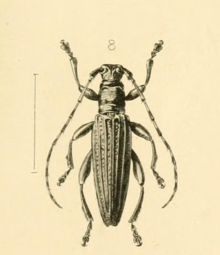Xylotoles costatus
| Xylotoles costatus | |
|---|---|

| |
| Illustration by Des Helmore | |
| Scientific classification | |
| Domain: | Eukaryota |
| Kingdom: | Animalia |
| Phylum: | Arthropoda |
| Class: | Insecta |
| Order: | Coleoptera |
| Infraorder: | Cucujiformia |
| Family: | Cerambycidae |
| Subfamily: | Lamiinae |
| Genus: | Xylotoles |
| Species: | X. costatus
|
| Binomial name | |
| Xylotoles costatus | |
Xylotoles costatus, the Pitt Island longhorn beetle, is a species of
Discovery and history of collection

Xylotoles costatus was first described and named by
Description and identification

Identification of Xylotoles costatus is difficult as it is very similar in appearance to another longhorn beetle found in the Chatham Islands, Xylotoles traversii. Both species are coloured black with a green bronze sheen, however it is likely that X. costatus has more of a bronze sheen than X. traversii. Of the two species X. costatus also has the more pronounced ridges on its wing cases. Generally X. traversii is the smaller beetle of the two, but the size of the two species can overlap. However, if a longhorn beetle specimen is found in the Chatham Islands that is greater than 16 mm in length it is likely to be X. costatus.[5]
Habitat
This species of longhorn beetle is usually found on the trunks of Coprosma chathamica at night. Recently dead or dying branches also attract adult beetles.[5]
Conservation and threats
As X. costatus is flightless and will spend time moving on the ground between trees, it is vulnerable to rodent predation. Knowing its exact habitat requirements as an adult and at the larval stage is thought to be a conservation priority.
References
- . Retrieved 17 November 2021.
- ^ "Xylotoles costatus". www.nztcs.org.nz. 2010. Retrieved 2019-03-07.
- ^ ISSN 0374-5481. Retrieved 30 August 2016.
- ^ ISBN 978-0-478-01833-2. Retrieved 30 August 2016.
- ^ hdl:10182/4165.
- ^ McGuinness, C.A. "The conservation requirements of New Zealands nationally threatened Invertebrates" (PDF). Retrieved 8 March 2019.
- ISSN 0077-9962.
- ^ "Schedule 7: Terrestrial and freshwater invertebrates declared to be animals". New Zealand Legislation. Retrieved 8 March 2019.
External links
- The Pitt Island longhorn discussed in RNZ Critter of the Week, 8 March 2019


